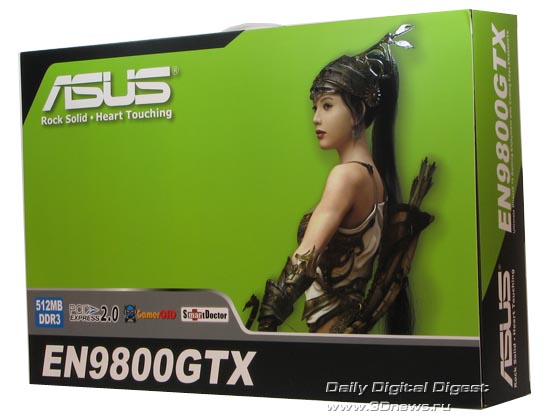GeForce 9800GTX vs middle-end video cards

Author:
Date: 30.05.2008 |
|
Recently, we already got an idea of GeForce 9800GTX, so this time we are approaching the matter from a different viewpoint. Our today's tests could be compared to street races, where high-end motor cars are competing on par against value motor cars, but this time instead of cars we'll be using video cards. As a high-end "motor-car", there will be ASUS 9800GTX, and as value "cars" - GeForce 8800GT, GeForce 9600GT, and Radeon HD3870. The idea of comparing these video cards have come to us after a substantial drop in their prices, so the difference in prices among the GeForce 9800GTX series video cards and the other three video cards tested today is sometimes as much as two-fold! So let's see which "bonuses" we got for the extra dollars.

Film studios should think of the screening of characters decorating the packages of huge numbers of video cards or whatever computer "rigs". For instance, the lady archer on the packages of ASUS video cards could make a real hero of a film in the fantasy style. We are not going to assume against whom she might fight so as not to offend none of the respected manufacturers.
The box opens up like a book.
That the boxes for ASUS 9800GTX opens up like a book (or a magazine) reminds you the idea to call the lady archer a pin-up girl. Under the cover there is a description of ASUS' proprietary utilities which can be examined in more detail in our previous review.
The rear side of the package is decorated in a more conservative style, its space is left for the specifications of the new product and the info about the manufacturer.
Package bundle.
ASUS 9800GTX offers the following package bundle:
- power supply adapter for PCI-Express video cards;
- S-Video/Component out adapter;
- DVI -> D-Sub adapter;
- drivers CD;
- Documentation CD;
- a CD wallet for 16 disks (of a new design, with a magnetic lock);
- brief installation guide.
The side view of the video card.
The front view of the video card.
The rear view of the video card.
Externally, ASUS 9800GTX is an almost complete replica of the GeForce 9800GTX reference sample, one of which was already reviewed.
Internal connectors of the video card.
The power connectors and the connector to plug in the digital S/PDIF signal are nearby on the side of the video card. It is strange that the package bundle contains only one power adapter, while there are two power connectors on the video card.
We have got acquainted with GeForce 9800GTX video card twice already, which you can read here and here, so we are not examining ASUS 9800GTX now - in any case, we won't find anything new in there. But we'll certainly check the efficiency of the cooling system and the overclocking capability of the video card.
Efficiency of the cooling system and overclocking
We'll be testing the efficiency of the cooling system of ASUS 9800GTX using the Firefly Forest test from the 3DMark 06 suite. The test conditions: the resolution 1600x1200, 4-X FSAA, and 16-X AF. After nine runs of the test we produced the following results:
The peak temperature after the warm-up.
The peak temperature did not exceed 72 C, which is a good result. As regards the clock speeds of the video card, they meet those recommended by NVIDIA and are equal to 675/1688 for the graphic processor and 2200 "efficient" MHz for the video memory. It should be noted that the real frequency of the shader domain is 1674 MHz, that is a bit lower than the value "hardcoded" to the BIOS. In terms of overclocking, the new product by ASUS has not lagged behind similar video cards of other manufacturers and coped with 756/2000 MHz for the GPU and 2406 MHz for the video memory. There is nothing more to add here, so let's move on to the test results.
 |
Content: |
 |
|
 |
Top Stories: |
 |
 |
 |
MoBo:


|
 |
 |
 |
VGA Card:


|
 |
 |
 |
CPU & Memory:

|
|
|
